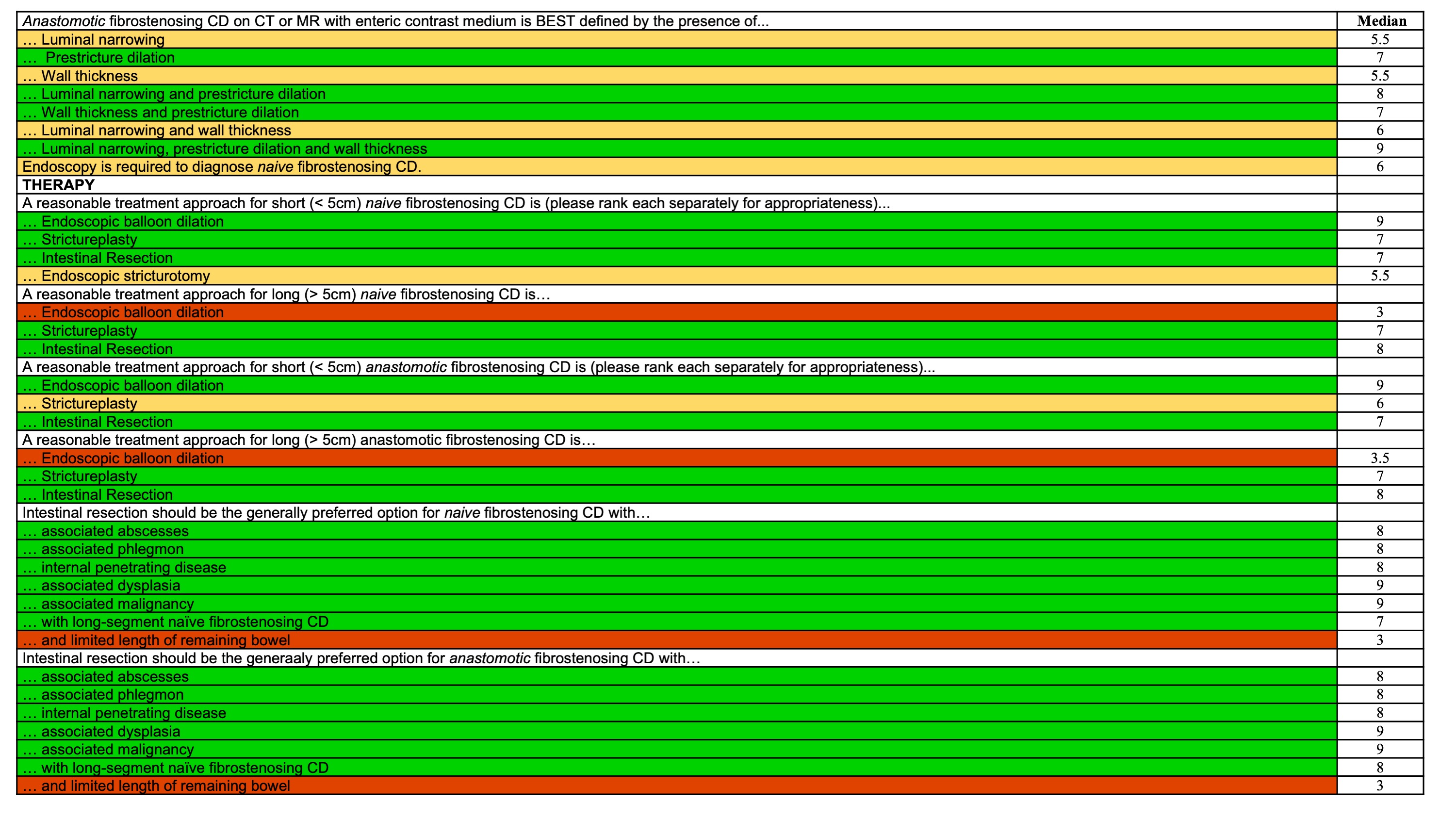P270 A global consensus on the definitions, diagnosis and management of fibrostenosing small bowel Crohn’s disease
Bettenworth, D.(1)*;Baker, M.E.(2);Bemelmann, W.(3);Bruining, D.(4);D’Haens, G.(5);D’Hoore, A.(6);Dignass, A.(7);Dotan, I.(8);Feagan, B.G.(9);Feakins, R.(10);Fleshner, P.(11);Fletcher, J.G.(12);Gordon, I.(13);Ha, C.(14);Gaylyn , H.(15);Jairath, V.(16);Lu, C.(17);Lyu, R.(18);Ng, S.C.(19);Panes, J.(20);Rogler, G.(21);Mao, R.(22);Rimola, J.(23);Sandborn, W.J.(24);Siegmund, B.(25);Silverberg, M.S.(26);Taylor, S.(27);Verstockt , B.(28);Rieder , F.(29);
(1)University of Münster, CED Schwerpunktpraxis Münster, Münster, Germany;(2)Abdominal Imaging Section- Imaging Institute, Digestive Diseases and Surgery and Cancer Institutes, Cleveland, United States;(3)UMC- Amsterdam, Department of Surgery- location Meibergdreef, Amsterdam, The Netherlands;(4)Mayo Clinic College of Medicine, Division of Gastroenterology and Hepatology, Rochester, United States;(5)Amsterdam University Medical Centers, Department of Gastroenterology, Amsterdam, The Netherlands;(6)University Hopitals Leuven, Department of Abdominal Surgery, Leuven, Belgium;(7)Agaplesion Markus Hospital- Goethe University, Department of Medicine I, Frankfurt/Main, Germany;(8)Rabin Medical Center- Petah-Tikva- Israel- Sackler Faculty of Medicine- Tel Aviv University, IBD Center- Division of Gastroenterology, Tel Aviv, Israel;(9)Alimentiv Inc, Department of Medicine- Western University- Department of Biostatistics and Epidemiology- Western University- London- Ontario- Canada-, London, Canada;(10)Royal Free London NHS Foundation Trust, Department of Cellular Pathology, London, United Kingdom;(11)Cedars-Sinai Medical Center, Division of Colon and Rectal Surgery, Los Angeles, United States;(12)Mayo Clinic, Department of Radiology, Rochester, United States;(13)Robert J. Tomsich Pathology and Laboratory Medicine Institute- Cleveland Clinic Foundation, Department of Pathology, Cleveland, United States;(14)Mayo Clinic Arizona, Department of Gastroenterology, Scottsdale, United States;(15)Atlanta, Atlanta, Atlanta, United States;(16)Alimentiv Inc and Western University, Department of Medicine- Department of Biostatistics and Epidemiology, London, Canada;(17)Division of Gastroenterology, Department of Medicine, Calgary, Canada;(18)Lerner Research Institute- Cleveland Clinic Foundation, Department of Quantitative Health Sciences, Cleveland, United States;(19)The Chinese University of Hong Kong, Division of Gastroenterology and Hepatology- State Key Laboratory of Digestive Disease, Shatin, Hong Kong- China;(20)August Pi i Sunyer Biomedical Research Institute- Biomedical Research Networking Center in Hepatic and Digestive Diseases, Hospital Clínic de Barcelon, Barcelona, Spain;(21)University Hospital Zurich, Center for Gastroenterology and Hepatology, Zurich, Switzerland;(22)The First Affiliated Hospital of Sun Yat-sen University, Department of Gastroenterology and Hepatology, Guangzhou, China;(23)Hospital Clínic de Barcelona, IBD Unit- Radiology Department, Barcelona, Spain;(24)University of California, San Diego, La Jolla, United States;(25)Charité - Universitätsmedizin Berlin, Medizinische Klinik für Gastroenterologie- Infektiologie und Rheumatologie, Berlin, Germany;(26)Mount Sinai Hospital, Division of Gastroenterology, Toronto, Canada;(27)University College London, Center for Medical Imaging, London, United Kingdom;(28)University Hospitals Leuven and KU Leuven, Dpt. Gastroenterology and Hepatology AND Department of Chronic Diseases and Metabolism, Leuven, Belgium;(29)Digestive Diseases and Surgery Institute and Lerner Research Institute- Cleveland Clinic Foundation, Department of Gastroenterology- Hepatology and Nutrition and Department of Inflammation and Immunity-, Cleveland, United States; on behalf of the Stenosis Therapy and Anti-Fibrotic Research (STAR) Consortium
Background
Small bowel fibrostenotic strictures are common in patients with Crohn’s disease (CD). No global consensus recommendations on definitions, diagnosis and clinical management are available.
Methods
Several systematic reviews followed by a RAND/University of California Los Angeles appropriateness study on the definitions, diagnosis and clinical management of fibrostenosing CD in clinical practice were performed. A panel of 28 global experts and a patient representative were convened. They assessed a total of 152 candidate items. The items were subsequently evaluated for appropriateness.
Results
No accurate predictive biomarkers are available for naïve or anastomotic fibrostenosing strictures. Accurate diagnosis of fibrostenosing CD requires cross-sectional imaging which should evaluate bowel wall thickness, luminal narrowing and prestenotic dilatation. A potential inflammatory component should be assessed. Abdominal cross-sectional imaging was considered necessary prior to any treatment decision. The panel proposed an approach to medical, endoscopic, and surgical therapies (Figure 1 and Table 1). Technical characteristics for endoscopic balloon dilation and follow up strategies after successful dilation therapy were identified. Appropriateness, types and performance of different surgical approaches in various settings were evaluated.



Conclusion
This global consensus provides clinical guidance for the diagnostic and therapeutic management of patients with fibrostenotic CD.


